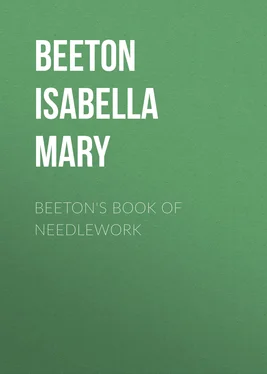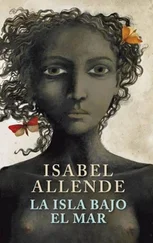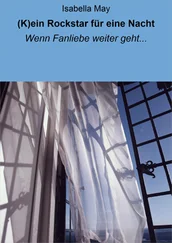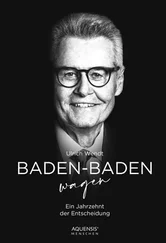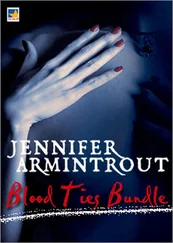Isabella Beeton - Beeton's Book of Needlework
Здесь есть возможность читать онлайн «Isabella Beeton - Beeton's Book of Needlework» — ознакомительный отрывок электронной книги совершенно бесплатно, а после прочтения отрывка купить полную версию. В некоторых случаях можно слушать аудио, скачать через торрент в формате fb2 и присутствует краткое содержание. Издательство: Иностранный паблик, Жанр: foreign_antique, foreign_home, Хобби и ремесла, на английском языке. Описание произведения, (предисловие) а так же отзывы посетителей доступны на портале библиотеки ЛибКат.
- Название:Beeton's Book of Needlework
- Автор:
- Издательство:Иностранный паблик
- Жанр:
- Год:неизвестен
- ISBN:нет данных
- Рейтинг книги:5 / 5. Голосов: 1
-
Избранное:Добавить в избранное
- Отзывы:
-
Ваша оценка:
- 100
- 1
- 2
- 3
- 4
- 5
Beeton's Book of Needlework: краткое содержание, описание и аннотация
Предлагаем к чтению аннотацию, описание, краткое содержание или предисловие (зависит от того, что написал сам автор книги «Beeton's Book of Needlework»). Если вы не нашли необходимую информацию о книге — напишите в комментариях, мы постараемся отыскать её.
Beeton's Book of Needlework — читать онлайн ознакомительный отрывок
Ниже представлен текст книги, разбитый по страницам. Система сохранения места последней прочитанной страницы, позволяет с удобством читать онлайн бесплатно книгу «Beeton's Book of Needlework», без необходимости каждый раз заново искать на чём Вы остановились. Поставьте закладку, и сможете в любой момент перейти на страницу, на которой закончили чтение.
Интервал:
Закладка:
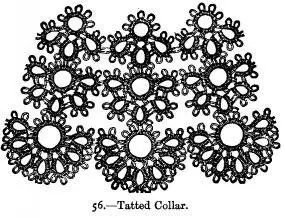
57.– Circle in Tatting .
Materials: Messrs. Walter Evans and Co's tatting cotton No. 50; tatting-pin No. 2.
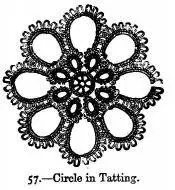
This circle is worked with fine cotton, and will be very pretty for ornamenting cravat-ends and different articles of lingerie. It is commenced in the centre with 2 double, 1 purl, repeated 8 times, draw the cotton into a ring, and work 8 small circles, as follow:–3 double, * 1 purl, 1 double, repeat from * 6 times, 1 purl, 3 double, draw up the cotton, and join it to the purl of centre ring and corresponding circle. Large circle: 3 double, * 1 purl, 2 double, repeat from * 14 times, 3 double, draw up the cotton, and join it to the 4th purl of small circle. The centre of ring is filled up with lace stitches.
58.– Tatting Medallion for Trimming Lingeries, &c.c.
Materials: Messrs. Walter Evans and Co.'s tatting cotton No. 50 for cravats and collars, 100 for pocket-handkerchiefs, 20 for petticoats; tatting-pin No. 2 or 3.
This pattern is suitable for trimming cravats, collars, pocket-handkerchiefs, petticoats, &c.c., according to the size of the cotton with which it is worked. Work first the round of circles which incloses the leaves, overlapping each other in the centre; begin with the smallest circle, which is at the top of the pattern; it consists of 3 double, 1 purl, 7 double, 1 purl, 7 double, 1 purl, 3 double. Then work at a short distance another circle like the preceding one, only work 8 double instead of 7, and instead of working the first purl, fasten the circle on to the last purl of the preceding circle; all the other circles are fastened on to each other in the same manner. The next circle, worked again at a distance of about one-fifth of an inch, has 4 double; fasten it on to the preceding circle, 9 double, 1 purl, 9 double, 1 purl, 4 double. The following four circles are worked like the preceding one; only work in the first of these circles 10 double instead of 9, in the second 11 double, in the third 12 double. The piece of cotton which joins the circles together must also be somewhat longer between the larger circles. Then work a circle as follows: 5 double, fasten the cotton, 13 double, 1 purl, 13 double, 1 purl, 5 double; then a similar circle, but always working 14 double instead of 13. The next circle consists of 6 double, fasten the cotton, 15 double, 1 purl, 15 double, 1 purl, 6 double; the two following circles are worked in the same manner, working 16 double instead of 15. Then comes the largest circle of the round, which consists of 6 double, 17 double, 1 purl, 17 double, 1 purl, 6 double. Work 11 circles more like the 2nd to 12th of those just described (the 13th circle forms the middle), only the order of sizes must be reversed, so that the round closes with the smallest circle. Then fasten both ends of the cotton together, so that the circles are joined into a circle. Then work round this row of circles another round, the circles of which must be of graduated sizes like those of the first round. Fasten the cotton on to the middle purl of the first small circle of the first round, and work one circle as follows:–3 double, 1 purl, 6 times alternately 2 double, 1 purl, then 3 double; fasten the cotton on to the middle purl of the next circle, &c.c. The remaining circles are worked in the same manner, only they must be increased and decreased in size gradually like the circles of the first round; this is done by increasing or decreasing the number of purl, instead of working the first purl of every following circle, fasten it on to the last purl of the preceding circle. When the round is completed, fasten both ends of the cotton together. In the centre of the oval pattern, fasten 6 five-branched patterns of graduated size, which are worked in one piece. For the smallest of these patterns work first three circles, consisting of 5 double, 1 purl, 5 times alternately 2 double, 1 purl, then again 5 double (these circles must be close to each other; the second and third circles must, moreover, be fastened on to the last purl of the preceding circle). The cotton is then fastened on the first circle between the beginning and the end of the same, then work close to them two small circles, consisting of 6 double, 1 purl, 6 double, fasten the cotton between the beginning and the end of the third circle. The other five-branched patterns are worked in the same manner at intervals of about three-tenths of an inch; but the separate circles of each pattern must become gradually larger. In the largest pattern the three large circles consist of 5 double, 1 purl, 8 times alternately 2 double, 1 purl, 5 double; the two smaller circles consist each of 15 double, 1 purl, 15 double; the size of the other patterns can easily be worked from this; the cotton which joins these last together is covered by over-casting with a needle and thread, so as to imitate double stitches. The five-branched patterns are then fastened in the oval pattern; they must overlap each other to half way, as seen in the illustration.
59.– Tatted Diamond .
Materials: Messrs. Walter Evans and Co.'s tatting cotton No. 40, or 80 if required finer; tatting-pin No. 3.
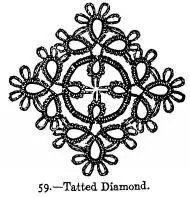
This pattern is meant to ornament lingerie; it is worked with fine tatting cotton in the following manner:–Work a * circle consisting of 6 double, 1 purl, 6 double, turn the circle downwards and work at a short distance another circle consisting of 5 double, 4 purl divided by 2 double, 5 double; at a similar distance a circle of 5 double fastened on to the last purl of the preceding circle, 2 double, 5 purl divided by 2 double, 5 double; then again a circle consisting of 5 double fastened on to the last purl of the preceding circle, 2 double, 3 purl divided by 2 double, 5 double: fasten the cotton on to the first circle. Then turn the work so that the last three circles are turned downwards, leave an interval of at least three-fourths of an inch, and repeat three times more from *, fastening the circles on to each other from illustration. Knot together the beginning and end of the cotton, work button-hole stitches round the cotton which joins the circles, as shown in illustration. The purl stitches of the four middle circles of the diamond are knotted together.
60.– Tatted Cravat End .
Materials: Messrs. Walter Evans and Co.'s tatting cotton No. 50; tatting-pin No. 3; 2 shuttles.
This cravat end is given in full size. It is ornamented with a tatted medallion, edged with lace. The tatting is worked with tatting fine cotton and two shuttles. Make first the two rosettes which form the centre of the medallion, then the insertion-like part which edges the rosettes. The larger rosette is worked as follows:–Knot the cotton of both shuttles together and work with 1 shuttle only 1 circle consisting of 10 double, 1 purl one-fifth of an inch long, 10 double; * close to this circle, which is turned downwards, work over the cotton with the other shuttle, 1 double, 1 purl, 8 double; this forms one of the scallops joining two circles. Then turn the work again and work close to the just completed scallop another circle like the first, but which is joined to the first circle instead of working the purl. Repeat 4 times more from *. Then work another scallop and fasten both ends of cotton on to the cotton over which the first scallop has been worked, at the place where the scallop is joined to the first circle. The first round of the rosette is thus completed.
Читать дальшеИнтервал:
Закладка:
Похожие книги на «Beeton's Book of Needlework»
Представляем Вашему вниманию похожие книги на «Beeton's Book of Needlework» списком для выбора. Мы отобрали схожую по названию и смыслу литературу в надежде предоставить читателям больше вариантов отыскать новые, интересные, ещё непрочитанные произведения.
Обсуждение, отзывы о книге «Beeton's Book of Needlework» и просто собственные мнения читателей. Оставьте ваши комментарии, напишите, что Вы думаете о произведении, его смысле или главных героях. Укажите что конкретно понравилось, а что нет, и почему Вы так считаете.
